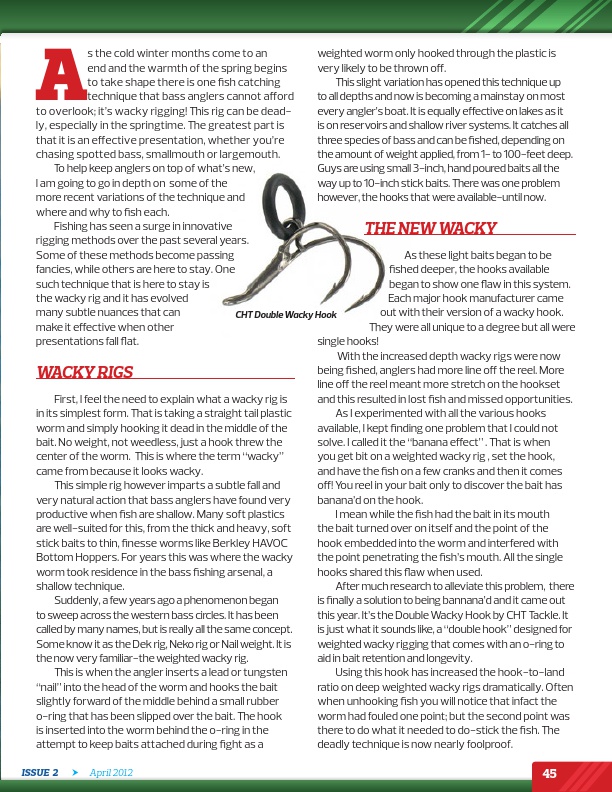
A
s the cold winter months come to an weighted worm only hooked through the plastic is end and the warmth of the spring begins very likely to be thrown off. to take shape there is one fish catching This slight variation has opened this technique up technique that bass anglers cannot afford to all depths and now is becoming a mainstay on most to overlook; it’s wacky rigging! This rig can be dead- every angler’s boat. it is equally effective on lakes as it ly, especially in the springtime. The greatest part is is on reservoirs and shallow river systems. it catches all that it is an effective presentation, whether you’re three species of bass and can be fished, depending on chasing spotted bass, smallmouth or largemouth. the amount of weight applied, from 1- to 100-feet deep. to help keep anglers on top of what’s new, Guys are using small 3-inch, hand poured baits all the l am going to go in depth on some of the way up to 10-inch stick baits. There was one problem more recent variations of the technique and however, the hooks that were available-until now. where and why to fish each. Fishing has seen a surge in innovative THE NEW WACKY rigging methods over the past several years. Some of these methods become passing as these light baits began to be fancies, while others are here to stay. one fished deeper, the hooks available such technique that is here to stay is began to show one flaw in this system. the wacky rig and it has evolved each major hook manufacturer came many subtle nuances that can out with their version of a wacky hook. Cht Double Wacky hook make it effective when other They were all unique to a degree but all were presentations fall flat. single hooks! With the increased depth wacky rigs were now being fished, anglers had more line off the reel. More WACKY RIGS line off the reel meant more stretch on the hookset and this resulted in lost fish and missed opportunities. First, i feel the need to explain what a wacky rig is as i experimented with all the various hooks in its simplest form. That is taking a straight tail plastic available, i kept finding one problem that i could not worm and simply hooking it dead in the middle of the solve. i called it the “banana effect” . That is when bait. No weight, not weedless, just a hook threw the you get bit on a weighted wacky rig , set the hook, center of the worm. This is where the term “wacky” and have the fish on a few cranks and then it comes came from because it looks wacky. off! You reel in your bait only to discover the bait has This simple rig however imparts a subtle fall and banana’d on the hook. very natural action that bass anglers have found very i mean while the fish had the bait in its mouth productive when fish are shallow. Many soft plastics the bait turned over on itself and the point of the are well-suited for this, from the thick and heavy, soft hook embedded into the worm and interfered with stick baits to thin, finesse worms like Berkley HaVoC the point penetrating the fish’s mouth. all the single Bottom Hoppers. For years this was where the wacky hooks shared this flaw when used. worm took residence in the bass fishing arsenal, a after much research to alleviate this problem, there shallow technique. is finally a solution to being bannana’d and it came out Suddenly, a few years ago a phenomenon began this year. it’s the double Wacky Hook by CHt tackle. it to sweep across the western bass circles. it has been is just what it sounds like, a “double hook” designed for called by many names, but is really all the same concept. weighted wacky rigging that comes with an o-ring to Some know it as the dek rig, Neko rig or Nail weight. it is aid in bait retention and longevity. the now very familiar-the weighted wacky rig. This is when the angler inserts a lead or tungsten Using this hook has increased the hook-to-land “nail” into the head of the worm and hooks the bait ratio on deep weighted wacky rigs dramatically. often slightly forward of the middle behind a small rubber when unhooking fish you will notice that infact the o-ring that has been slipped over the bait. The hook worm had fouled one point; but the second point was is inserted into the worm behind the o-ring in the there to do what it needed to do-stick the fish. The attempt to keep baits attached during fight as a deadly technique is now nearly foolproof.
April 2012
Issue 2
45